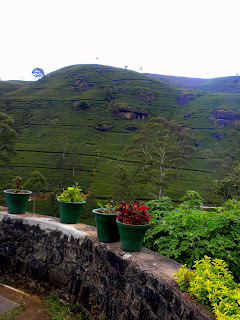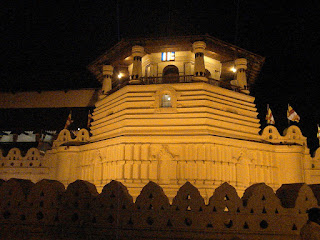•Low Grown Tea (Pahatha rata) is grown at altitudes of less than 600 m (1900ft) above sea level.
•Mid Grown Tea (Medarata) grows in areas from 600 to 1200 m above sea level.
But, Lankesh assured me, the best tea is
•High Grown Tea (Udarata), grown above 1200m.
This area was our day’s destination.
The British had introduced tea to Ceylon in the mid-nineteenth century by importing plants from China. Several years later, they were glad they had when the coffee plantations, thriving at the time, were destroyed by a fungal disease. Plantation owners had to switch to tea or go out of business.
The Singhalese were not keen to work on the plantations so the British “imported” Tamils from India (not the same as the Tamils up north who arrived much earlier in the history of the country). Their descendents are still the main workers in today’s industry.
I found out later that the tea workers are some of the poorest people in Sri Lanka –-perhaps not surprising in a labor-intensive industry that employs mainly women and girls – some as young as twelve – who come largely from a minority ethnic group. Tourists don’t get told everything. They want us to be happy.
Early in the afternoon, we arrived at Mackwoods Tea Factory, on the Mackwoods Labookellie Estate. (The Sri Lankan government nationalized the tea estates about 40 years ago; hence the “old” British name is linked to the “new” Sri Lankan one.)

Here I learned that there is more to tea than just picking, packing and shipping.
First, tea leaves are “plucked”.

The same field can be plucked about once a week all year long.
The pluckers choose two soft leaves and a bud over and over again.

Bags of leaves come to the factory three or four times a day.

Yes this is one man carrying up to 80 kg (176 lb) of tea leaves.
The next step in the process is “withering”

The tea leaves are laid out in troughs and for 10 to 14 hours air is circulated in them to dry out any surface moisture and concentrate and break down the tea juices.
Then, the withered tea leaves are sent down this chute

to the room below. Here the leaves are rolled (twisted to bring the juices to the surface) and passed through another machine which separates the rolled from the not-yet-rolled leaves. The not-yet-rolled are sent back to try again.

The rolled leaves are put into fermentation vats for a few hours.

Did you know that tea was fermented? I certainly didn’t. But this is what makes the leaves turn brown. Then the fermented tea leaves are dried for 20 or 25 minutes.

Finally they are graded

and remaining impurities – like bits of twig – are removed.

Finally the tea is ready to be packed up and sent to Colombo to the tea auctions.

My head whirling from all this new information, I was happy to go out to the terrace and enjoy my complimentary taste of the result of all this work

and the view of the tea leaves that still had all this in their future

with a vow never to gulp down a cup of tea thoughtlessly ever again.





































.JPG)











